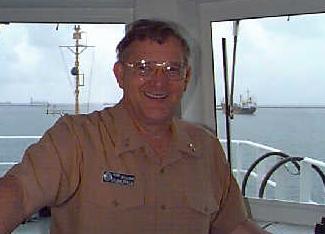
Rear Admiral William L. Stubblefield
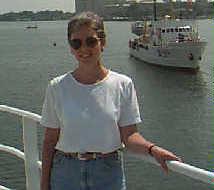 Ms. Mary Landahl
Ms. Mary Landahl
As a "Teacher at Sea" I will be interviewing people who work on the NOAA ship R/V RONALD BROWN (we call it the RON BROWN). I will also be interviewing a few of the visitors.
It takes many different people doing a variety of jobs to make a ship run smoothly. The RON BROWN is a scientific research ship. In addition to highly skilled NOAA officers and ship crew needed to operate the ship safely, a scientific crew is needed as well, to collect high-quality data that will be used by scientists for years to come. We have people working hard, around the clock, using all types of skills and performing at a high level to accomplish our mission on this cruise. It is amazing who you find on a ship in the middle of the Pacific Ocean.
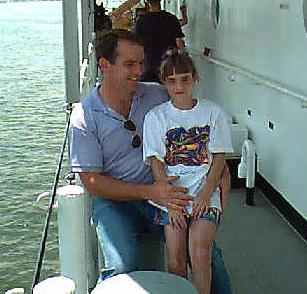
My first interview is with a very young visitor to the ship. Laura Beth Stricker rode from the NOAA dock in Norfolk, Virginia to a fueling station. She was with her father, Jim Stricker, who is a Port Engineer. Laura is 8 & 1/2 years old, lives in Chesapeake, Virginia, and attends Chittum Elementary School. She is in third grade. Laura is very interested in the ocean. She likes sea creatures of all kinds, such as dolphins, manatees, horseshoe crabs, and sea urchins. She loves the water and ships, especially cruise ships. Laura has had the opportunity to be on cruise ships to the Bahamas, and the U.S. Virgin Islands. When asked what she would like to be when she grows up Laura thoughtfully replied, "An explorer!" Good luck and study hard Laura, I'll be thinking about you when we are out at sea.

Rear Admiral William L. Stubblefield
We were fortunate to have the director of the National Oceanic and Atmospheric Administration (NOAA) Office of NOAA Corps Operations, Rear Admiral William L. Stubblefield, onboard ship from Charleston, SC to Panama.
As director of NOAA Corps Operations, Admiral Stubblefield is responsible for managing NOAA's fleet of research and survey ships, research and mapping aircraft, diving operations, and all NOAA Corps personnel. The overall mission of NOAA is to map and chart the ocean floor, conduct oceanographic and meteorological research, and manage fisheries. NOAA is also the major sponsor of the PACS Tropical Eastern Pacific Process Study Cruise.
Admiral Stubblefield has kept a high level of dedication and interest in his work throughout his life by looking for challenging assignments. As a result, he has had an illustrious career. He has traveled as deep as 12,000 feet below sea level in the NOAA "Alvin" research submarine and as high as 45,000 ft above sea level in the Gulf Stream 4, a jet aircraft used to study hurricanes. From operating remote under sea research equipment to traveling to Antarctica, he has easily remained enthusiastic about his work.
What was Admiral Stubblefield's path to a successful career? He attended college at Memphis State in Tennessee. He spent five years in the Navy working on interesting, exciting, and challenging assignments. He has served on a minesweeper and on an ice breaker. After the Navy he attended the University of Iowa and received a master's degree. He joined NOAA and later went back to school for his Ph.D. in geological oceanography from Texas A&M University.
This intelligent, dignified, and friendly man attributes most of his success to a good work ethic and a spirit of competition instilled in him in his youth. As an example of this, in high school he had little talent in basketball but loved to play. He practiced very hard, knowing he had to make up for a lack of innate abilities. He persevered because of his competitive nature; as a result he became an outstanding player. These early lessons translated to other areas of life.
Admiral Stubblefield shares a special relationship with his wife of 22 years, Dr. Bonnie McGregor, who is the Assistant Director of the United States Geological Survey (USGS). They were the first husband and wife team onboard a NOAA research vessel. He was the captain of the ship and she was the chief scientist. The Admiral has a lot of pride and admiration for his wife and her extraordinary accomplishments.
Some advice the Admiral has for young people who are interested in a career at NOAA is to first pursue a degree in science and keep your grades high. Second, become affilated with a good scientist and get involved in group projects. He believes learning to work well in groups and participating in extra projects is as important, if not more important, than what school you attend. Third, work hard to develop communication skills; you need to have the ability to be your own advocate and to express your interests and ideas clearly. Finally, take on the challenging assignments and have fun.
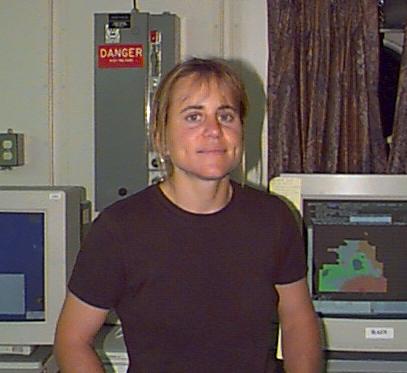
Dr. Yolande L. Serra was born and raised in Connecticut and now she is doing postdoctoral work at the University of Washington. Dr. Serra studies the atmospheric boundary layer and tropical meteorology. She is interested in comparing data collected on this experiment in the tropical eastern Pacific with data collected in the western Pacific during another meteorological experiment called Tropical Ocean Global Atmosphere Coupled Ocean Atmosphere Response Experiment (TOGA COARE).
Her job on the ship is to collect data and track soundings. A sounding is a group of atmospheric measurements taken by sending an instrument up into the atmosphere with an helium balloon. The instrument called a sonde is equipped with a series of sensors that measure air temperature, dew point, and pressure. These measurements are electronically recorded and radioed back to the ship. This is the data that Dr. Serra will record and analyze.
Dr. Serra received an undergraduate degree in Biophysics from the University of California, San Diego. For her doctoral work she attended the Scripps Institution of Oceanography; Dr. Serra's Ph.D. is in Physical Oceanography. She studied the fluid dynamics of the ocean. Fluid dynamics is the motion of the ocean, such as currents, tides, and atmospheric turbulence. Her interests vary but she is particularly interested in how the lower atmosphere and the ocean interact.
To Dr. Serra, one of the hardest parts of this experiment is recording and taking data so that it is usable in the future. She wants to make sure the data are accurate, the record keeping clear, and that everything possible is collected. What Dr. Serra likes most about this job is that she can be in the same place that the data are being collected at the same time. She feels that this helps build her scientific intuition.
Dr. Yolande Serra does her work with enthusiasm; besides work she plays Ultimate Frisbee, hikes, travels, and plays the guitar. She is intelligent, athletic, and has an adventurous spirit. Advice she gives to young people is to not let anyone tell you that you can't do something. Always pursue your interests.
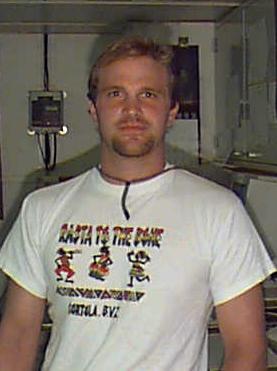 General Vessel Assistant Scott Dirks
General Vessel Assistant Scott Dirks
Mr. Scott Dirks was born in Seattle, Washington and now lives 90 miles north of Seattle in a rural area near Bellingham, Washington. He is a General Vessel Assistant working on the deck crew of the RONALD H. BROWN. With his qualifications he can also be assigned to the Engineering or Steward department. As a person on the Deck crew Mr. Dirk's duties vary quite a bit. The Deck crew is responsible for the general upkeep of the ship, they assist the scientists, set up and service scientific equipment, run the ship board cranes, pilot the Rigid Hull Inflatable Boat (RHIB), and participate in emergency services.
No stranger to the ocean, Mr. Dirks has been around water his entire life. He spent eight years in the Navy where he was a machinist. After the Navy, Mr. Dirks cooked his way through college. He has a degree in Ocean Technology from Shoreline Community College and a degree in Environmental Studies from Western Washington University.
Mr. Dirks knew about the National Oceanic and Atmospheric Administration (NOAA) from all his years at sea. A year after he finished college he pursued a position with NOAA. In retrospect he says he did not plan to go back to sea but that is where he is most employable. Mr. Dirks is gaining valuable experience but would like to be doing more things directly related to his field.
Getting out in the RHIB, especially in the big swells, is one of the best parts of the job for Mr. Dirks. He also enjoys participating in assisting the scientific teams. One of the least pleasant aspects of his job is having to sort the trash. This is a necessary job because of the demands of waste management at sea. Garbage can't be dumped into the ocean; some things can be incinerated, others must be saved for recycling or dumping when the ship gets back into port. But the worst part of his job is leaving his wife at home for long periods of time while he is at sea.
Mr. Dirks has many interests such as reading, diving, working out and playing softball. As a matter of fact he said a qualification for marriage was that the woman he would spend the rest of his life with had better know how to throw a ball. He's looking forward to playing softball, running with dogs in the woods and cooking a big meal for his friends and neighbors. Mr. Dirks' words of advice for young people are to try to get as many different experiences as you can and to make the best of what might seem like a failure. You can always learn from experiences good and bad.
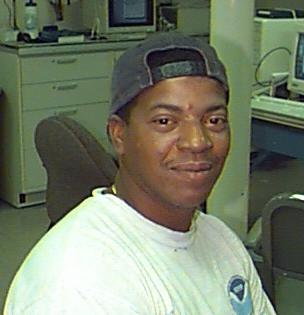 General Vessel Assistant Reginald D. Williams
General Vessel Assistant Reginald D. Williams
Mr. Reginald "Reggi" D. Williams is a General Vessel Assistant on the RONALD H.BROWN. He has worked for the National Oceanic and Atmospheric Administration (NOAA) for six years. Mr. Williams was born in New Jersey but now calls the ship "home". Most of his family lives in Hampton, Virginia, where he has stored most of his personal belongings that he doesn't need on the ship.
As a General Vessel Assistant, Mr. Williams works in the Deck department but can be moved to other areas. While on the Deck crew he maintains the decks by painting and cleaning them inside and out. Mr. Williams also gets to drive the ship, walk security rounds, and keep watch on the bridge. He, like all the other members of the crew, is responsible for emergency services. Another aspect of his job is helping the scientists load and unload, set up, and sometimes operate their equipment. This depends upon the type of scientific mission onboard the ship. On one mission he participated in making ocean floor maps which he found very interesting.
Mr. Williams has 11 years experience in the Navy. His naval experiences made him more than qualified for this job in NOAA. He became a General Vessel Assistant by filling out the general federal government job application. The government hiring services found the NOAA position and then matched it with his qualifications. This is a popular way of finding federal jobs around the country.
There are hard tasks that Mr. Williams is asked to do but the most difficult thing for him is when he has to climb; he is afraid of heights. He never has refused to do a job because there is climbing involved, but it is something he doesn't especially enjoy doing. By contrast there are many parts of the job he really loves, such as traveling and meeting people from all over the world. This job gives him the opportunity to save money. He is confined to the ship for most of the year, and as a result isn't tempted to spend money.
Mr. Williams is a fun-loving man who likes bowling, dominoes, and cards. He likes to work out. There is an exercise room on the ship that he, like many other people on the ship, uses on a regular basis. Of all the places he's visited, Mr. Williams enjoyed Australia the most. He found the people friendly and the wildlife (kangaroos and big bats) very interesting. Other favorite spots are St. Thomas, the Seychelles, and South Africa.
The advice he has for young people is to stay away from drugs and alcohol. Mr. Williams has seen first hand how they can mess up a person's life. He also suggests that you travel when you are young because it is harder to travel when you have a family and other responsibilities.
Questions about the cruise? Send them to edc(at)atmos.washington.edu.